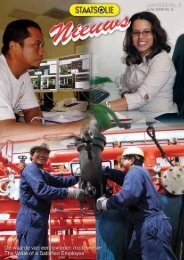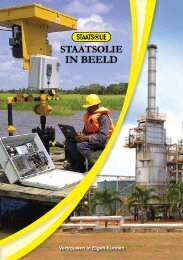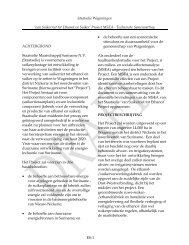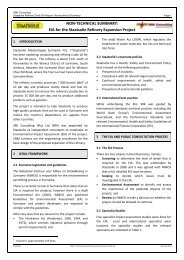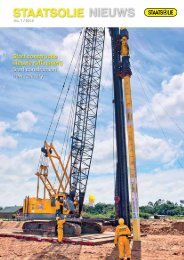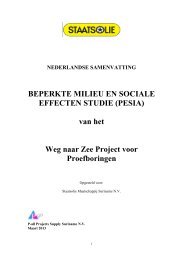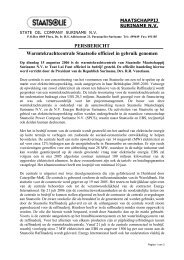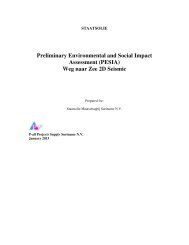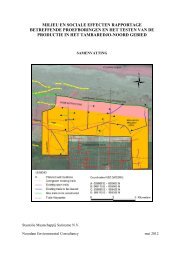concept EIA-rapport - Staatsolie
concept EIA-rapport - Staatsolie
concept EIA-rapport - Staatsolie
Create successful ePaper yourself
Turn your PDF publications into a flip-book with our unique Google optimized e-Paper software.
SRK Consulting: Project No: 439414 <strong>Staatsolie</strong> Pipeline <strong>EIA</strong> – Draft <strong>EIA</strong> Report Page 73<br />
Product<br />
Location<br />
On land<br />
LPG spill Diesel/gasoline spill<br />
A full-bore LPG pipeline breach would<br />
result in a complex two-phase choked<br />
gas flow. The possibility of a significant<br />
flash fire resulting from delayed remote<br />
ignition is extremely low due to the<br />
buoyant nature of the vapour, which<br />
generally precludes the formation of a<br />
persistent flammable vapour cloud at<br />
ground level. The dominant hazard is<br />
thermal radiation from a sustained jet or<br />
trench fire, which may be preceded by a<br />
short-lived fireball.<br />
Spillage of gasoline and diesel could result in an<br />
unignited vapour cloud, pool fire or, in the case of<br />
gasoline, a delayed flash fire. The risk due to toxic<br />
cloud formation, either as an unignited cloud or a<br />
burning pool (jet fire) is low.<br />
As discussed above, the intensity of an impact would depend on the volume and type of pollutants<br />
released and the type of environment into which it is released. Particularly, a spill of diesel or<br />
gasoline in the Suriname River could cause an impact of regional extent through the dispersion of<br />
the fuel on the river, while the intensity of an impact from a jet fire could be high. In all cases, it is<br />
expected that the pollutant will disperses relatively quickly, particularly in the water, and that any<br />
terrestrial areas can be remediated.<br />
The potential impact from an accidental release of hydrocarbons due to a pipeline leakage or rupture<br />
is therefore assessed to be of medium significance (negative) without mitigation (Table 6-13).<br />
The implementation of the recommended mitigation measures would reduce the likelihood of an<br />
incident (which is not reflected in the rating below) and the extent and intensity of an impact by<br />
shortening the response time, thereby limiting the amount of fuel that is spilled before the leak can<br />
be stopped. The overall significance of the impact, should it occur, reduces to very low (negative)<br />
after mitigation.<br />
Table 6-13: Significance of accidental release of hydrocarbons from the pipeline – Operation<br />
Extent Intensity Duration Consequence Probability Significance Status Confidence<br />
Without<br />
mitigation<br />
Regional<br />
2<br />
High<br />
3<br />
Short-term<br />
1<br />
Medium<br />
6<br />
Probable MEDIUM -ve Medium<br />
Essential mitigation measures:<br />
To reduce the probability of an incident (does not affect significance rating):<br />
• Design the pipelines to minimise the risk of failure (including coating and weld inspection)<br />
• Regularly monitor and maintain the pipelines through smart pigging to prevent failures.<br />
• Install a cathodic protection system and maintain in good order.<br />
• Regularly inspect the pipeline corridor to detect anything that could damage the pipeline.<br />
To reduce the impact in the event of an incident:<br />
• Avoid drilling through sand bodies, as far as possible.<br />
• Maximise the vertical distance between pipelines and the Zanderij aquifer (aim for 10 m or more).<br />
• Maintain a minimum distance of 200 m from drinking water wells along the pipeline route.<br />
• Aim to leave a layer of bentonite in the drill hole to act as further sealant for the pipeline.<br />
• Monitor and compare product volumes entering and exiting the pipelines for indications of lost product.<br />
• Ensure adequate spill response measures are included in the Emergency Response Plan.<br />
• Notify MAS and adjacent landowners immediately in the event of a spill.<br />
• Ensure adequate spill containment and response equipment are available, including oil booms and oil spill<br />
dispersants.<br />
• Ensure all relevant staff are trained in the requirements of the Emergency Response Plan and in the use of spill<br />
containment and response equipment.<br />
With<br />
mitigation<br />
Local<br />
1<br />
Medium<br />
2<br />
Short-term<br />
1<br />
Very low<br />
4<br />
Probable VERY LOW -ve Medium<br />
REUT/DALC 439414_<strong>Staatsolie</strong>Pipeline<strong>EIA</strong>_Draft <strong>EIA</strong> Report_Final June 2012




